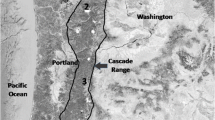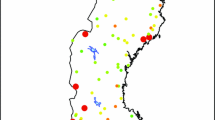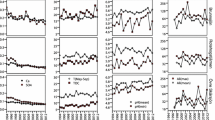Abstract
Although the acidification of lakes and streams in several parts of the world as a consequence of the emission and deposition of S and N oxides is well-documented1–4, no direct measurement by continuous monitoring of acidification rate of any lake has been reported. In many cases, historical data have been compared to recent data and acidification of aquatic systems, generally over periods of decades, demonstrated. But methodological changes have always compromised the results. In other cases, historical chemical conditions of lakes and streams have been inferred from either geochemical relationships5 or from palaeolimnological records6,7 and compared to current conditions. Here we present the first direct observations of the acidification rate of a lake that has undergone extensive damage to its aquatic biota as the result of deposition of acids of anthropogenic origin. A threefold decrease in alkalinity and a decrease of 0.2 pH units occurred in the lake despite a reduction in the deposition rate of strong acids over the period of study. Acidification was accompanied by a decrease in base cation content in the lake but not an increase in strong acid anion (SO2–4) concentration, indicating that there has probably been a depletion of available cations in the lake's catchment.
Similar content being viewed by others
References
National Research Council Acid Deposition Long-term Trends (National Academy Press Washington DC, 1986).
Environmental Protection Agency The Acidic Deposition Phenomenon and Its Effects, Critical Assessment Review, Vol. II. (eds Altshuller, A. P. & Linthurst, R.) EPA-600/8-83-016 BF (1984).
Harvey, H. H. et al. Acidification in the Canadian Aquatic Environment. Natn. Res. Council Can. Publ. No. 18475 (1981).
Wright, R. F. Predicting Acidification of North American Lakes. Norwegian Institute for Water Research Rep. 4/1983 (1983).
Henriksen, A. Nature 278, 542–545 (1979); Changes in Base Cation Concentrations Due to Freshwater Acidifications. Norwegian Institute for Water Research Rep. 1/1982 (1982).
Flower, R. J. & Battarbee, R. W. Nature 305, 130–133 (1983).
Jones, V. J., Stevenson, A. C. & Battarbee, R. W. Nature 322, 157–158 (1986).
LaZerte, B. D. & Dillon, P. J. Can. J. Fish. Aquat. Sci. 41, 1664–1677 (1984).
Stumm, W. & Morgan, J. J. Aquatic Chemistry. An Introduction Emphasizing Chemical Equilibria in Natural Waters 2nd edn (Wiley, New York, 1981).
Haines, T. A. Trans. Am. Fish. Soc. 110, 669–707 (1981).
Dillon, P. J., Yan, N. D. & Harvey, H. H. CRC crit. Rev. Envir. Contr. 13, 167–194 (1984).
Krug, E. C. & Frink, C. R. Science 221, 520–525 (1983).
Almer, B. et al. Ambio 3, 30–36 (1974).
Davis, R. B., Anderson, D. S. & Berge, F. Nature 316, 436–438 (1985).
Oliver, B. G., Thurman, E. M. & Malcolm, R. L. Geochim. cosmochim. Acta 47, 2031–2035 (1983).
Morrison, I. Mineral Nutrition of Conifers with Special Reference to Nutrient Status Interpretation: a Review of Literature. Can. Forest Serv. Publ. No. 1343 (1974).
Harvey, H. H. & Lee, C. Historical Fisheries Changes Related to Surface Water pH Changes in Canada. Acid Rain/Fisheries, Proceedings of an International Symposium on Acidic Rain and Fishery Impacts on Northeastern North America, Cornell University, Ithaca, New York (1982).
Servos, M. R., Rooke, J. B. & Mackie, G. L. Can. J. Zool. 63, 511–515 (1985).
Stephenson, M. & Mackie, G. L. Can. J. Fish. Aquat. Sci. 43, 288–292 (1986).
France, R. L. & LaZerte, B. D. Can. J. Fish. Aquat. Sci. (in the press).
Jackson, M. B. Wat. Air Soil Pollut. (in the press).
Schindler, D. W. et al. Science 228, 1395–1401 (1985).
Magnuson, J. J., Baker, J. P. & Rahel, E. J. Phil. Trans. R. Soc. B305, 501–516 (1984).
Author information
Authors and Affiliations
Rights and permissions
About this article
Cite this article
Dillon, P., Reid, R. & de Grosbois, E. The rate of acidification of aquatic ecosystems in Ontario, Canada. Nature 329, 45–48 (1987). https://doi.org/10.1038/329045a0
Received:
Accepted:
Issue Date:
DOI: https://doi.org/10.1038/329045a0
- Springer Nature Limited
This article is cited by
-
Remote mountain lakes of Eastern Siberia: a pattern of ecologically pure non-industrialised water-bodies
Environmental Earth Sciences (2017)
-
Diatoms indicate that calcium decline, not acidification, explains recent cladoceran assemblage changes in south-central Ontario softwater lakes
Journal of Paleolimnology (2014)
-
Controls Over Base Cation Concentrations in Stream and River Waters: A Long-Term Analysis on the Role of Deposition and Climate
Ecosystems (2013)
-
Effects of multiple stressors on lakes in south-central Ontario: 15 years of change in lakewater chemistry and sedimentary diatom assemblages
Aquatic Sciences (2013)
-
Evaluating long-term trends in littoral benthic macroinvertebrate communities of lakes recovering from acid deposition
Environmental Monitoring and Assessment (2012)





